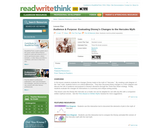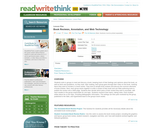
This lesson is for 7th grade students reading A Long Walk to Water.
- Subject:
- English Language Arts
- Material Type:
- Activity/Lab
- Author:
- Carrie Robledo
- Date Added:
- 03/25/2022

This lesson is for 7th grade students reading A Long Walk to Water.

This is a project centering around students writing any narrative story of their choosing. The teacher will go through the process of labeling the parts of a story with a narrative as a class and demonstrate why each one fits in that story element. Students will then be given a topic to write their own story on that will fit into each labeled story element. Students will then be asked to summarize these events into visual images that will be created using CoSpaces. They will then be challenged to create at least 3 different stories out of the same original events they created on their CoSpaces story cube.

This resource accompanies our Rethink 7th Grade ELA course. It includes ideas for use, ways to support exceptional children, ways to extend learning, digital resources and tools, tips for supporting English Language Learners and students with visual and hearing impairments. There are also ideas for offline learning.

This parent guide supports parents in helping their child at home with the 7th grade ELA content.

In this unit, students will be reading and writing myths following the structure of short stories and eventually publishing their own work.

The 7th grade poetry unit gives an in-depth approach to poetry. Included are worksheets, rubrics, and answers keys where applicable along with CCSS literature examples.

This teacher's guide for Addie on the Inside by James Howe contains discussion questions, activities, and research assignments.

Seven-year old Annie Dillard enjoys playing football with the boys in her neighborhood because it requires her to play with concentration and courage. In this CCSS lesson, students will explore this story through text dependent questions, academic vocabulary, and writing assignments.

Seventeen-year-old best friends dream of becoming light-weight boxing champions of the world. They train together until they find out that they will meet in the ring to determine who will fight in a championship tournament. In this CCSS lesson, students will explore this story through text dependent questions, academic vocabulary, and writing assignments.

In this lesson, students will continue to analyze working conditions in the mill and how they affect Lyddie. This lesson adds a focus on word choice and figurative language, as students discuss how author Katherine Paterson’s choice of language helps the readers better understand Lyddie’s working conditions and how they affected her.

This is a hands-on project that uses George Orwell's novel, Animal Farm, as the touchstone text. Students work in groups to construct a functioning windmill that can generate electricity. Each student has a role based on the characters in the book. There are also segments of the project that focus on extracting key information from the text.

This is a poem about love that Poe has written in memory of his wife, whom he calls Annabel Lee. In this CCSS lesson, students will explore this story through text dependent questions, academic vocabulary, and writing assignments.

This resource is a collection of discussion questions to supplement The Art of Racing in the Rain by Garth Stein.

In this lesson, the students will read and reread the passage closely and focusing their reading through a series of questions and discussion about the text, students will be able to understand the structure and purpose of this particular soliloquy and how it delves into universal themes regarding the human condition.

In this CCSS lesson, students will explore this story through text dependent questions, academic vocabulary, and writing assignments. Printable text files included.

What drives changes to classic myths and fables? In this lesson students evaluate the changes Disney made to the myth of "Hercules" in order to achieve their audience and purpose.

A teachers guide for Betsey Brown by Ntozake Shange, including chapter-specific questions for increased comprehension, questions for class discussion, and suggestions for further study.

Students work in groups to read and discuss a book, keeping track of their feelings and opinions about the book, as well as facts and quotations, as they read. Students then decide which parts of their review they wish to annotate, with each student in the group responsible for one topic. Each student writes about his or her topic, including bibliographic information.

This teacher's guide for The Boy on the Wooden Box by Leon Leyson with Marilyn J. Harran and Elisabeth B. Leyson contains discussion questions and activities for reading comprehension, learning about craft and structure, integrating information, and writing practice.

This language arts lesson offers a hands-on opportunity for students to understand characterization in literature and to connect historical and contemporary culture. Through research and study of Shakespearean England, student pairs get to know about the life of a character in the book Shakespeare Stealer. Students collect props and clues to create a “life box” and a poem about their character. Using props adds a visual and physical dimension to their learning while using words engages mental facilities, making this a whole brain activity. Students must communicate their clues and interpret others clues to reveal character’s identities.